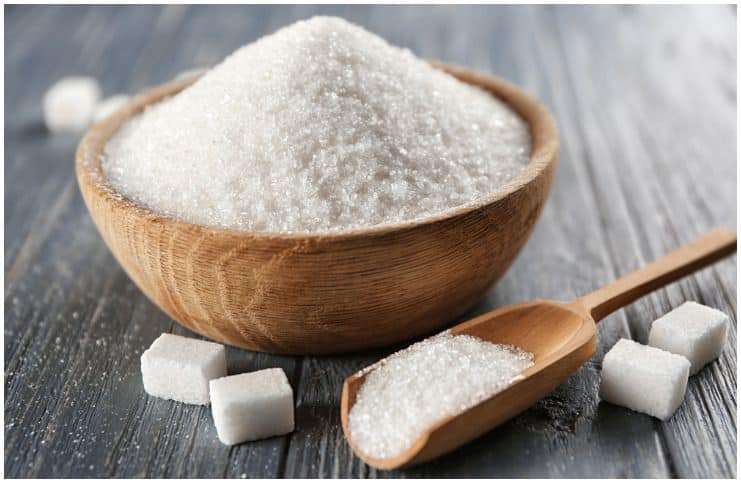Artificial Sweeteners Side Effects and Disadvantages During Pregnancy & Weight Loss:
All artificial sweeteners are chemically processed. Because these substances are many times sweeter than table sugar, smaller quantities are needed to create the same level of sweetness.
They are so intensely sweet that maltodextrin or dextrose, or both, must be added to dilute their intense sweetness in order to imitate the sweetness of sugar.
They are widely used in processed foods, including baked goods, chewing gum, soft drinks, powdered drink mixes, instant coffee, chewable vitamins, ice cream, candy, puddings, canned foods, jams and jellies, dairy products, and almost all diet products.
List Of Artificial Sweeteners
#1 E 951 – Aspartame
Aspartame is approximately 200 times sweeter than sugar. This substance is one of the most present on the market, included in more than 6,000 products worldwide, either alone or in combination with E954 (saccharin).
It is found in the form of a white crystalline powder or in granular form. Aspartame is not recommended for people with PKU (phenylketonuria). Their body is unable to break down one of the amino acids used to make aspartame.
This 2014 study by Cesare Maltoni Cancer Research Center, Ramazzini Institute, Italy, established that E951 may impair memory performance and increase oxidative stress in the brain. (1)
#2 E 952 – Cyclamate
Cyclamate is used in the manufacture of biscuits, soft drinks, pastries, jams, and canned fruits. The sweetening power of cyclamate varies between 30-80, depending on the food product. In high concentrations, its sweetness is affected by an unpleasant residual component.
#3 E 950 – Acesulfame K
Acesulfame K (K for Potassium) is an artificial sweetener discovered in 1967. This compound is found in the form of a white crystalline powder or colorless crystals. E950 has no calories because it’s not metabolized by the body.
It is mixed together with other sweeteners, such as saccharin, in carbonated low-calorie beverages and other food products.
The sweet taste of E 950 installs rapidly, and it resembles the one of sucrose at low concentrations; at higher concentrations, the taste of acesulfame K is affected by a slight bitter residual component, less intense than that of E 954.
#4 E 954 – Saccharin (Sweet Twin, Sweet ‘N Low or NectaSweet)
It was discovered in 1879, presenting in the form of colorless crystals, sometimes gaining a white hue. E 954 is obtained from petroleum.
Its sweetness depends on how it is used and ranges from 200 to 700 times sweeter than sugar. It may have a bitter or metallic aftertaste in some liquids.
This substance was suspected of promoting cancer, so both its commercialization and consumption was banned in Canada.
#5 E 955 – Sucralose (Splenda)
It is 300 times sweeter than sugar and does not contain any calories. This sweetener is also marketed as such, under the name of “Splenda,” and is combined with other substances such as maltodextrin and dextrose.
Because of its high stability, E 955 can be used in products that require heat treatment or prolonged storage periods. Sucralose is used commonly in frozen dairy desserts, soft drinks, chewing gum, and sweets.
A 2013 study published in the Journal of Toxicology and Environmental Health, concluded that cooking with E 955 at high temperatures can generate dangerous chloropropanols, which are a toxic class of chemical compounds. (2)
#6 Advantame
Advantame is the last artificial sweetener approved by the FDA. It is synthesized from aspartame and isovanillin and is 20,000 times, gram per gram, sweeter than sugar.
As in the case of aspartame, however, people suffering from phenylketonuria disorder should not eat it because it contains phenylalanine.
#7 E 960 Steviol glycosides (Truvia, Sun Crystals, Pure Via)
Steviol glycosides are natural compounds of the leaves of Stevia rebaudiana, a plant native to parts of South America and usually known as Stevia.
They are non-nutritive sweeteners and are reported to be 200 to 400 times sweeter than table sugar. The use of crude stevia extracts and stevia leaf is not considered GRAS, and their import into the U.S. is not permitted for use as sweeteners.
#8 Monk Fruit (Nectresse)
It is the powdered extract of monk fruit, a round green melon that grows in central Asia.
#9 E 961 Neotame
This sweetener is structurally different, which makes it about 40 times sweeter than E 951, or approximately 8,000 times sweeter than sugar.
Used in many diet foods and drinks, E 961 can be used in the same foods and beverages as both acesulfame K and aspartame. It was approved by the FDA in 2002 and by the European Union in 2010.
#10 E 967 Xylitol
It is slowly and only partially absorbed in the intestine and is converted into glucose in the liver. It is added to a range of foods, oral health products, and medications.
The EU’s Scientific Committee on Food said in a 1985 report that consuming 50g a day of E 967 can cause diarrhea. (3)
#11 E 956 Alitame
This compound is formed from the amino acids aspartic acid and alanine.
There is cause for concern because it is very chemically similar to aspartame, which has many known side effects. Not yet approved in the USA.
#12 E 968 Erythritol
This sugar alcohol is about 70% as sweet as sugar. Erythritol’s relative safety is due to the fact that it’s mostly absorbed into the bloodstream and excreted unchanged in urine.
#13 E 962 Aspartame-acesulfame Salt
E 962 is an artificial sweetener marketed under the name Twinsweet. It is produced by soaking a 2-1 mixture of aspartame and acesulfame potassium in an acidic solution and allowing it to crystallize.
The rights of E 962 are now owned by NutraSweet Company Inc, which has continued to market the chemical substance successfully in the EU and USA.
#14 E 953 Isomalt
Isomalt is manufactured from sugar. In the United States, this substance is usually derived from GMO sugar beets. Isomalt is poorly absorbed by the body, which signifies it has only half the calories of sugar.
#15 E 421 Mannitol
E 421 is a sugar alcohol, also called a polyol. Most E 421 commercially available is synthesized from fructose, which can be GMO.
#16 E 966 Lactitol
Lactitol is a sugar alcohol, also called a polyol. It is made from lactose or milk sugar, so it’s not beneficial for people with a dairy allergy or lactose intolerance.
#17 E 965 Maltitol
Maltitol is a sugar alcohol, also called a polyol. Maltitol is most usually derived from corn but can also be derived from wheat.
#18 E 959 Neohesperidine dihydrochalcone
This sweetener was discovered as part of a U.S. Department of Agriculture research program to find techniques for masking the taste of bitter flavors in citrus juices.
Research has shown that at strengths of around and above 20 ppm, E 959 can produce side effects such as migraine and nausea.
Side effects of artificial sweeteners
Manufacturers, marketers, and others with financial interests have successfully convinced millions of consumers that chemicals used in artificially sweetened products are safe. If you’re consuming a beverage or food created in a lab instead of by nature, you can be assured your body doesn’t recognize it.
This opens the door to short-term and long-lasting health problems for you.
During pregnancy
There is limited evidence to support the use of artificial sweeteners during pregnancy. The American Medical Association suggests avoiding saccharin during pregnancy due to possible slow fetal clearance.
Also, in a report published in JAMA Pediatrics, researchers led by Meghan Azad studied more than 3,000 pregnant women and their infants.
They found that moms who reported consuming more artificial sweeteners, such as saccharin, sucralose, and aspartame in beverages, were twice as likely to have children who were obese or overweight at one year, compared to women who reported using artificial sweeteners less. (4)
Weight Gain
We consume artificial sweeteners sometimes without knowing and sometimes deliberately, thinking they are effective for controlling blood sugar and weight.
However, a 2014 review, which summarized the findings of 9 observational studies, found that artificial sweeteners were linked with a slightly higher body mass index. (5)
Type 2 diabetes
There is conflicting research surrounding the health benefits of artificially sweetened foods. A 2013 study at the Center for Research in Epidemiology and Population Health, France, concluded that both artificially sweetened beverages and sugar-sweetened beverages were associated with an increased risk of developing type 2 diabetes. (6)
In addition, diabetics must count these unnatural sweeteners as part of their carbohydrate limits since insulin is required for their metabolism.
The American Diabetes Association and American Heart Association have given a cautious nod to the use of these sweeteners in place of sugar to combat metabolic syndrome, obesity, and type 2 diabetes, all risk factors for heart disease.
The statement also points out that these potential benefits will not be fully realized if there is a compensatory increase in energy intake from other sources, ultimately saying that at this time, there is insufficient data to make a conclusive determination about using non-nutritive sweeteners. (7)
Conclusion
Usually, you reach for artificial sweeteners for a few reasons: weight loss or trying to kick a sugar addiction.
Unfortunately, most artificial sweeteners do not reach these health goals: they don’t help you lose weight, they can make your sweet cravings worse, plus they have many health side effects.

